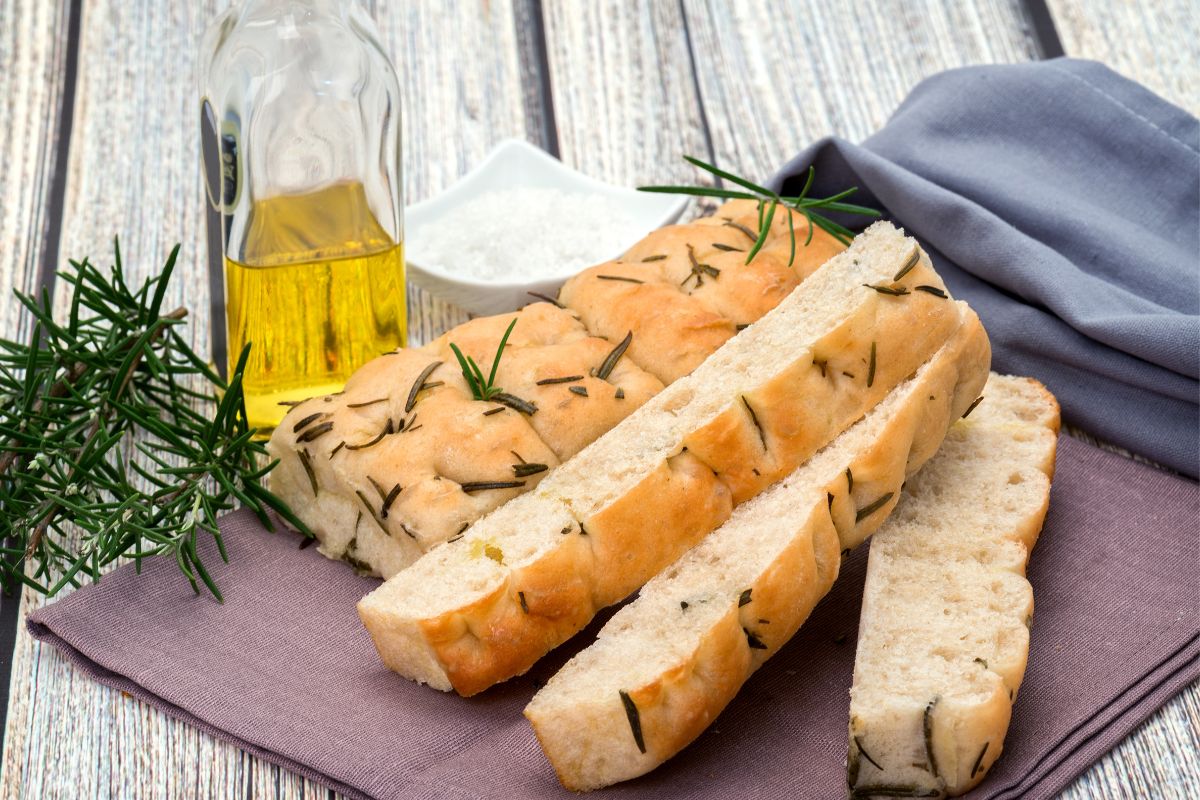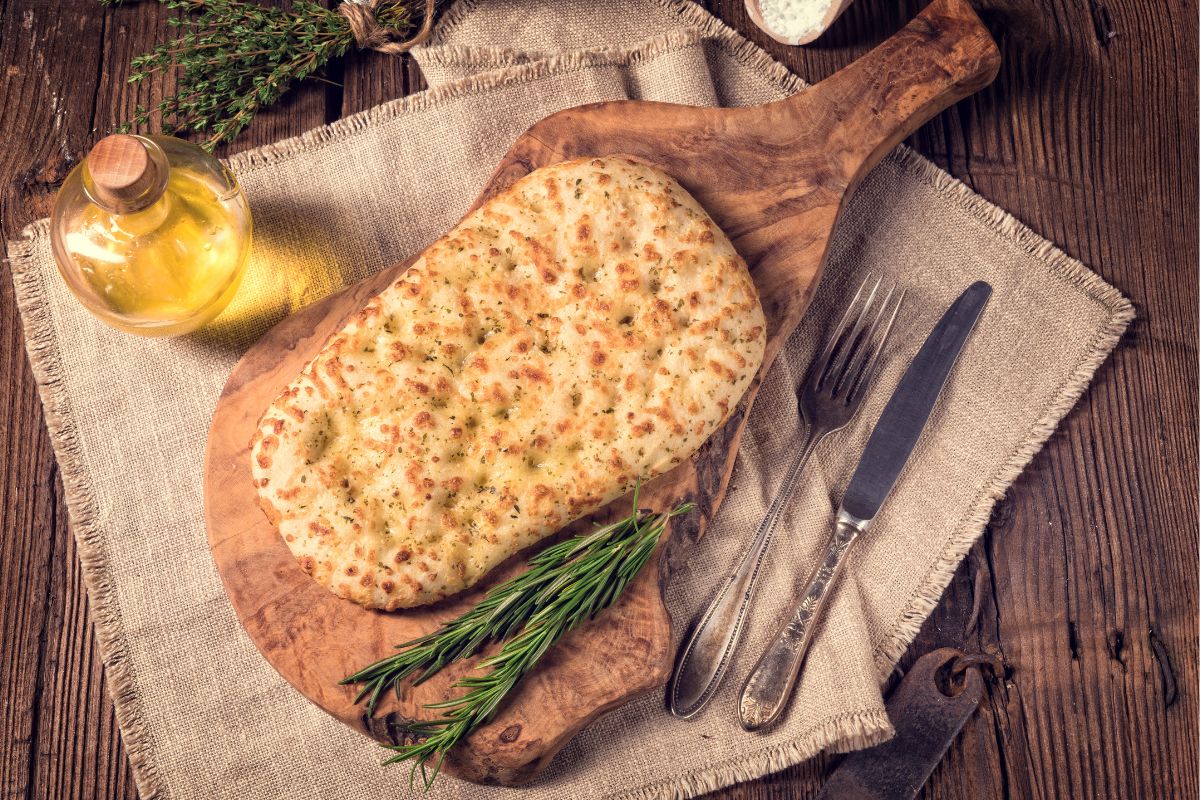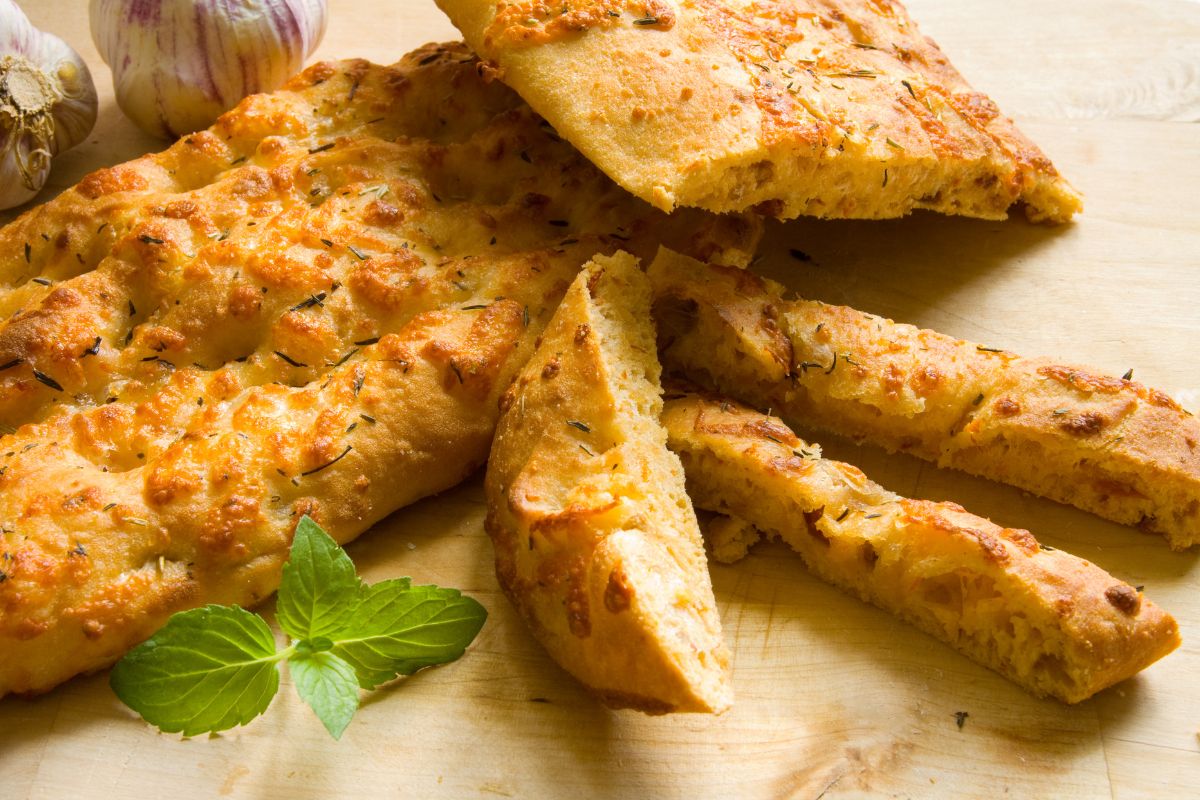What is Focaccia Bread?
This article highlights how to store focaccia bread. Focaccia is a type of bread you bake on oil-coated sheet pans, resulting in a delightful flavor of olive oil, a chewy texture, and a crispy exterior with dimples. You can top this Italian flatbread with various ingredients, including fresh rosemary, cherry tomatoes, parmesan, and sea salt.
You can enjoy it as a tasty antipasto side dish, as sandwich bread, or simply dip it in olive oil and seasonings.

What is it Made of?
Focaccia bread combines basic ingredients, including flour, yeast, olive oil, water, and salt. The dough is typically a product of strong flour, such as bread flour, which is high in gluten.
Focaccia bread’s versatility allows you to enjoy it on its own. Also, you can cut it into various shapes and serve it alongside a meal. Additionally, if the bread becomes stale, you can repurpose it into croutons or homemade breadcrumbs. The ability to take on both sweet and savory variations makes focaccia bread a flexible choice for various meals throughout the day.
What is the Origin of Focaccia Bread?
Focaccia bread traces its origins to the northern shores of the Mediterranean and has been a favorite meal in Italy and beyond for centuries.
The term “focaccia” finds its roots in the Roman words “panis focacius,” meaning “hearth bread” or “center bread,” indicating its traditional method of baking in coals during Roman times. People cooked early versions of focaccia on the hearth of a hot fire or a heated tile, resembling other related flatbreads.
The history of focaccia has links to various regions and cultures. It gained popularity in Italy and was later introduced to communities worldwide by Italian settlers. For centuries, many have associated focaccia with Christmas Eve and Epiphany traditions in Italy.
As the Roman Empire expanded into France and Spain, focaccia traveled with them, contributing to its widespread appeal across continental Europe. Initially a staple for peasants and rural communities, its popularity transcended borders as European immigrants carried their focaccia recipes to different parts of the world.
In Italy, diverse regions created variations of focaccia, incorporating an array of savory and sweet flavorings and toppings. This evolution extends globally, with variations like “foisse” or “fouaisse” in Burgundy, France, and “fugazza” in Argentina.
Overall, the history of focaccia reflects its deep connections to Mediterranean and European culinary traditions, showcasing diverse regional adaptations and a lasting influence on global cuisine.
How to Store Focaccia Bread
The optimal way to preserve the freshness of focaccia bread depends on your consumption timeline. Room temperature storage is ideal for enjoying it within a few days.
Alternatively, freezing is best for a longer shelf life, up to one month. Only refrigerate if your focaccia contains perishable ingredients like cheese or meat. You can leave simple rosemary focaccia unrefrigerated.
Room Temperature Storage
For fresh Italian focaccia, wrap it in plastic or an airtight container at room temperature. To make handling easier, cut the loaf into smaller pieces. Wrap these pieces first in plastic wrap and then in aluminum foil. Store them in a plastic bag. Using this method, homemade focaccia will remain fresh for two or three days.
Freezer Storage
Slice the focaccia into squares, then flash-freeze them on a baking sheet lined with parchment paper, leaving space between each piece. You can keep the frozen focaccia squares in the freezer for up to a month after freezing for two hours. After that, wrap them in plastic wrap and place them in freezer bags.
Cooling Before Storage
Ensure your focaccia is completely cool before storing it. Once cooled, you have several other storage options than the ones already mentioned:
- Airtight container: Line a container with a paper towel, top with the cooled focaccia slices, and store at room temperature for up to two days. The paper towel absorbs excess moisture to keep the focaccia from getting soggy.
- Paper bag: Place focaccia in a paper bag and close the end. It will last up to a day but may become hard. Soften it in the microwave.
How to Store Focaccia Bread Overnight
For the best way to store focaccia bread overnight and maintain its freshness, follow these steps:
- Cool completely: Allow the focaccia to cool completely after baking. This ensures that condensation won’t form inside the storage container, which can make the bread soggy.
- Wrap tightly: Wrap the cooled focaccia tightly in plastic wrap. This helps keep the moisture in and prevents the bread from drying.
- Airtight container: Alternatively, you can place the wrapped focaccia in an airtight container. To preserve its softness, consider lining the container with a paper towel to help absorb any excess moisture.
- Room temperature: Store the wrapped or containerized focaccia at room temperature. Avoid the refrigerator, as the cold environment can cause the bread to dry out faster.
- Reheat if necessary: If the focaccia bread has lost some freshness the next day, reheat it in the oven to revive its texture. Preheat the oven to a low temperature, wrap the focaccia in aluminum foil, and heat for 10-15 minutes.
By following these steps, you can enjoy your focaccia the next day with minimal loss of freshness and flavor.
How to Reheat Focaccia
You can reheat focaccia quickly while preserving its texture and flavor. Here’s a simple guide on how to reheat focaccia:
Method 1: Oven
- Preheat the oven: Preheat your oven to around 350 degrees Fahrenheit (175 degrees Celsius).
- Wrap in foil: Wrap the focaccia in aluminum foil, ensuring the seal is not too tight.
- Reheat: Place the foil-wrapped focaccia in the preheated oven for about 10-15 minutes or until it reaches your desired warmth.
- Unwrap and crisp (optional): For a crisper crust, unwrap the focaccia for the last few minutes of reheating.
- Serve: Once reheated, remove it from the oven and serve immediately.
Method 2: Toaster Oven
- Preheat the toaster oven: Preheat your toaster oven to a medium setting.
- Slice and arrange: If the focaccia is thick, consider slicing it into smaller pieces. Arrange the slices on the toaster oven rack.
- Reheat: Place the slices in the toaster oven for a few minutes until warmed through.
- Serve: Once heated, take it out, and it’s ready for serving.
Method 3: Microwave
- Slice: If the focaccia is thick, slice it into smaller, microwave-friendly pieces.
- Dampen a paper towel: Moisten a paper towel and place it over the focaccia to add a bit of moisture.
- Microwave: Microwave on a medium setting for 20-30 seconds at a time until it’s heated to your liking.
- Serve: Once heated, serve immediately.

Can You Freeze Focaccia Bread?
Yes, you can freeze focaccia bread to extend its shelf life. Here’s a guide on how to freeze and thaw focaccia:
Freezing Focaccia
- Cool completely: Allow the focaccia to cool completely after baking or purchasing.
- Wrap well: Wrap the entire loaf or individual slices tightly in plastic wrap. Ensure that the wrap is airtight to prevent freezer burn.
- Double protection: Place the wrapped focaccia in a resealable plastic freezer bag or aluminum foil for an extra layer of protection.
- Label and date: Label the package with the freezing date to help you keep track of freshness.
Thawing Focaccia
- Overnight in the refrigerator: The best way to thaw frozen focaccia is to transfer it from the freezer to the refrigerator. Allow it to defrost overnight.
- Room temperature: If you need to thaw it quickly, let it come to room temperature on the counter. Depending on the loaf size or slices, this may take a few hours.
- Reheating: Once thawed, refresh the focaccia by reheating it in the oven. Begin by preheating the oven to a low temperature, around 300-325 degrees Fahrenheit (149-163 degrees Celsius). Wrap the bread in an aluminum foil, and heat for 10-15 minutes. This will help restore its texture and flavor.
Avoid thawing focaccia in the microwave directly from the freezer, as it may result in a soggy texture. The gradual thawing in the refrigerator or at room temperature helps preserve the quality of the bread.
Can You Freeze Focaccia Dough?
Yes, you can freeze focaccia dough to use at a later time. Here’s a guide on how to freeze focaccia dough:
- Prepare the dough: Follow your focaccia dough recipe until the initial mixing and kneading stages are complete.
- Divide into portions: If making a large batch, consider dividing the dough into portions suitable for a single use. This makes it easier to thaw only the amount you need.
- Shape and package: Shape the dough portions into balls or whatever form suits your recipe. Wrap each piece tightly in plastic wrap, ensuring it’s well-sealed to prevent freezer burn. Place the dough portions in a resealable plastic freezer bag or wrap them in aluminum foil for added protection.
- Label and date: Label each package with the date and any specific instructions for baking or shaping, if needed.
How Long is Focaccia Bread Good For?
The shelf life of focaccia bread depends on storage conditions and ingredients. If stored properly, it can last two to three days at room temperature in an airtight container or wrapped in plastic. Refrigerating extends freshness for about a week, but it may affect texture. For longer storage, freezing is an option, lasting up to two to three months.
What To Do With Store-Bought Foccacia Bread
Serving Ideas for Store-Bought Focaccia Bread
- Classic dipping: Serve slices of focaccia with a side of high-quality olive oil and balsamic vinegar for dipping. Add a sprinkle of sea salt and cracked black pepper for extra flavor.
- Bruschetta: Toasted or grilled focaccia slices make an excellent base for bruschetta. Top with diced tomatoes, garlic, basil, and a drizzle of balsamic glaze for a tasty appetizer.
- Focaccia pizza: You can transform focaccia into a quick and easy pizza crust by topping it with pizza sauce, cheese, and toppings for a flavorful alternative to traditional pizza.
- Focaccia Panini: Create paninis using focaccia as the bread. Fill it with your preferred ingredients, grill until golden and melty, and enjoy a warm and satisfying sandwich.
- Focaccia toast: Make savory or sweet toasts by slicing and toasting focaccia. Top with avocado, eggs, or Nutella for a versatile and tasty snack.
- Focaccia croutons: Cube and bake focaccia to make homemade croutons for salads or soups. The seasoned crust of the focaccia adds a flavorful twist to your dishes.
Other Focaccia Bread Recipes to Explore
- Mediterranean focaccia: Incorporate Mediterranean flavors with toppings like olives, feta cheese, cherry tomatoes, and oregano.
- Rosemary and sea salt focaccia: Keep it simple with classic toppings of fresh rosemary and sea salt for a timeless and flavorful option.
- Caramelized onion focaccia: Add sweetness and depth of flavor with caramelized onions as a topping.
- Sun-dried tomato and pesto focaccia: Elevate your focaccia with the bold flavors of sun-dried tomatoes and a drizzle of pesto.
- Garlic and herb focaccia: Infuse your bread with the aromatic goodness of garlic and a mix of fresh herbs for a fragrant and savory option.
Remember, store-bought focaccia provides a versatile canvas for various culinary creations, so feel free to get creative with your toppings and enjoy the delicious results.
Can I Refrigerate Focaccia Bread?
It’s generally not recommended to store focaccia in the refrigerator unless necessary. However, if your focaccia has perishable toppings like fresh cheese, it’s advisable to refrigerate it for safety reasons. Toppings such as cheese can attract harmful bacteria when left at room temperature.
A Homemade Focaccia Bread Recipe
Time: 2 hours 30 minutes
Serving size: 8 -10 servings
Prep time: 15 minutes
Cook time: 20 – 25 minutes
Nutritional Facts:
- Calories: 142
- Fat: 4.5g
- Sodium: 320mg
- Carbohydrates: 20.4g
- Fiber: 1g
- Sugars: 1g
- Protein: 5g
- Calcium: 20mg
- Folate: 78.7mcg
- Phosphorus: 73mg
- Potassium: 65mg
- Monounsaturated fatty acids: 3.32g
Equipment Needed
- Mixing bowls
- Measuring utensils
- Stand mixer or hand mixer (optional)
- Baking pans
- Parchment paper
- Plastic wrap or kitchen towel
- Cooling rack
- Spatula
- Sharp knife or pizza cutter
Ingredients
- 4 cups bread flour
- 2 teaspoons flaky sea salt
- 2 teaspoons instant yeast
- 2 cups of warm water
- Butter
- Rosemary (optional)
Directions
- In a bowl, whisk salt, flour, and yeast together.
- Add water and use a spatula to stir the mixture thoroughly.
- Generously coat the dough with olive oil to prevent drying.
- Cover the bowl with plastic wrap, a lid, or a cloth and refrigerate for 12 to 18 hours or up to three days.
- Ensure the dough is adequately slicked with olive oil, especially using a cloth cover or tea towel to avoid drying and crust formation.
- Meanwhile, preheat the oven to 425 degrees Fahrenheit (220 degrees Celsius).
- When ready to proceed, remove the dough from the fridge and uncover it.
- Deflate the dough and transfer it to a prepared pan.
- For glass baking dishes, butter them before adding a tablespoon of olive oil.
- Depending on your environment, allow the dough to rest undisturbed for two to four hours.
- After the resting period, sprinkle rosemary over the dough if desired.
- Pour at least two tablespoons of olive oil over the dough. Use your fingers to press down, creating deep dimples.
- Sprinkle with flaky sea salt (e.g. Maldon) for added flavor.
- Immediately transfer the prepared dough to a preheated oven. Bake the dough for approximately 25 minutes or until golden.
- Once baked, remove the focaccia and let it cool on the cooling racks.
Four Success Tips
- Let the dough rest in the fridge for 18 to 24 hours for optimal results. Extending this period up to 72 hours is also acceptable.
- To prevent sticking, use a buttered or parchment-lined pan in addition to olive oil. If using glass pans like Pyrex, a combination of butter and oil is essential; however, olive oil alone is sufficient with a pan.
- Plan for a two to four-hour second rise, dependent on your kitchen’s temperature and the time of year.
What are Some Common Toppings for Focaccia Bread?
Focaccia bread offers a range of delicious toppings, including:
- Onions: Sliced onions cooked in olive oil and salt, layered on the focaccia before baking.
- Tomatoes: Ripe, sweet tomatoes broken up and arranged on the focaccia, complemented by olive oil, salt, and oregano.
- Herbs: You can use garlic, thyme, and oregano individually or in combination to infuse the focaccia with rich flavors.
- Cheese: Explore options like herbed cream cheese, mozzarella, or roasted varieties on top of the focaccia.
- Vegetables: Roasted pears, onions, broccoli, and tomatoes can add flavor and texture to the focaccia.
- Fruits and nuts: Grapes, figs, plums, and nuts provide a delightful sweet-salty contrast to the focaccia.
Mix and match these toppings to create an array of flavors and textures, showcasing the versatility and customization of focaccia bread.
Is Focaccia Bread a Healthy Option?
Focaccia bread can contribute to a healthy diet when consumed in moderation. It offers complex carbohydrates that provide a gradual release of energy. However, being mindful of portion sizes and maintaining a balanced diet is crucial.
Can Focaccia Bread Fit into a Vegan Lifestyle?
Focaccia bread has the potential to be vegan or non-vegan, depending on the chosen recipe and ingredients. The fundamental elements of traditional focaccia, such as flour, salt, yeast, water, and olive oil, are typically vegan.
Nevertheless, variations and additional ingredients can influence the bread’s vegan status. Therefore, it’s essential to carefully review the specific recipe and toppings used to ensure they align with a vegan lifestyle.

Summary
In conclusion, properly storing focaccia bread is essential for preserving its delightful texture and flavor. Whether you baked or purchased it, following the correct storage methods can significantly impact the bread’s freshness. Cool the focaccia entirely before wrapping or placing it in an airtight container.
Opt for room temperature storage over refrigeration, which helps maintain the bread’s optimal texture. If necessary, reheating in the oven can revitalize the focaccia’s crispness. With these simple steps, your focaccia bread remains a delicious treat, whether you enjoy it immediately or store it for later consumption.

Community of passionate writers and content creators who share a love for Italian heritage, culture, travel, food, and the Italian-American community. Our mission is to celebrate Italy’s rich history and traditions and connect with others who share the same passion.


